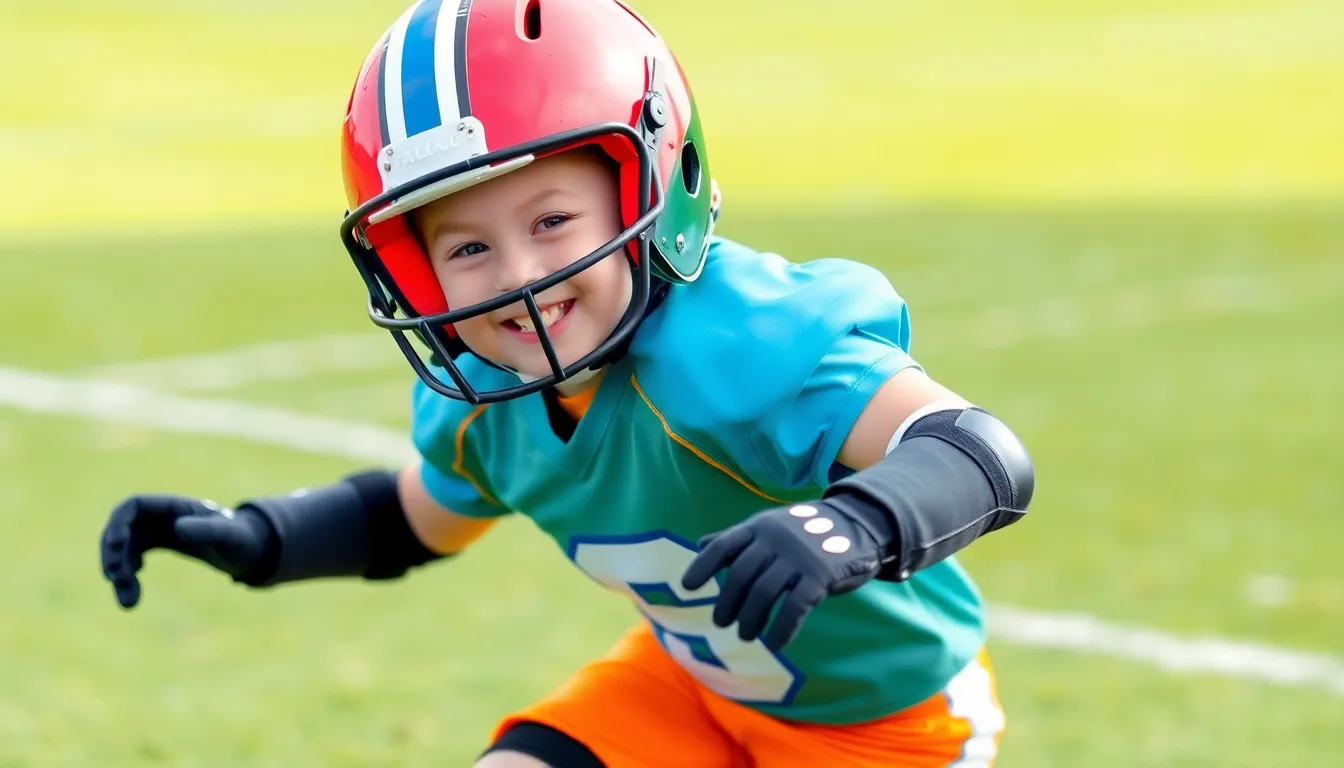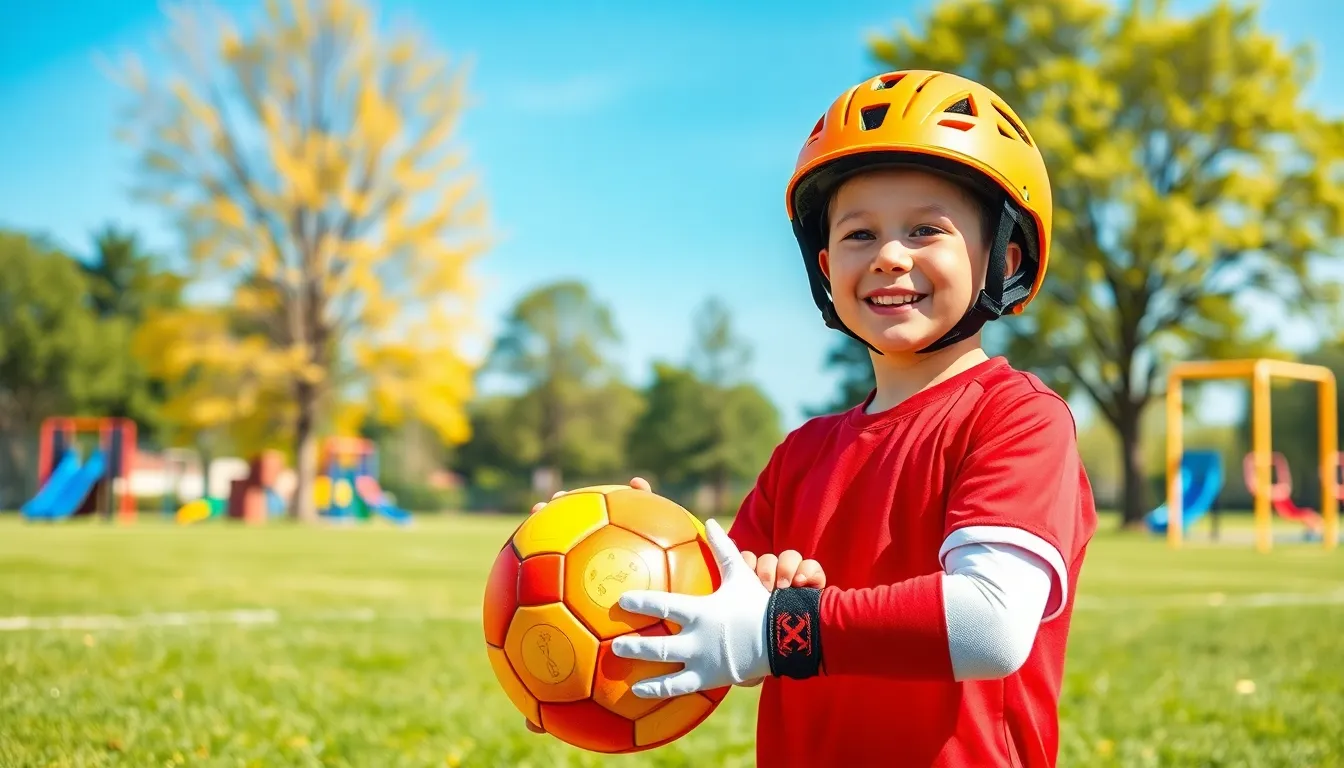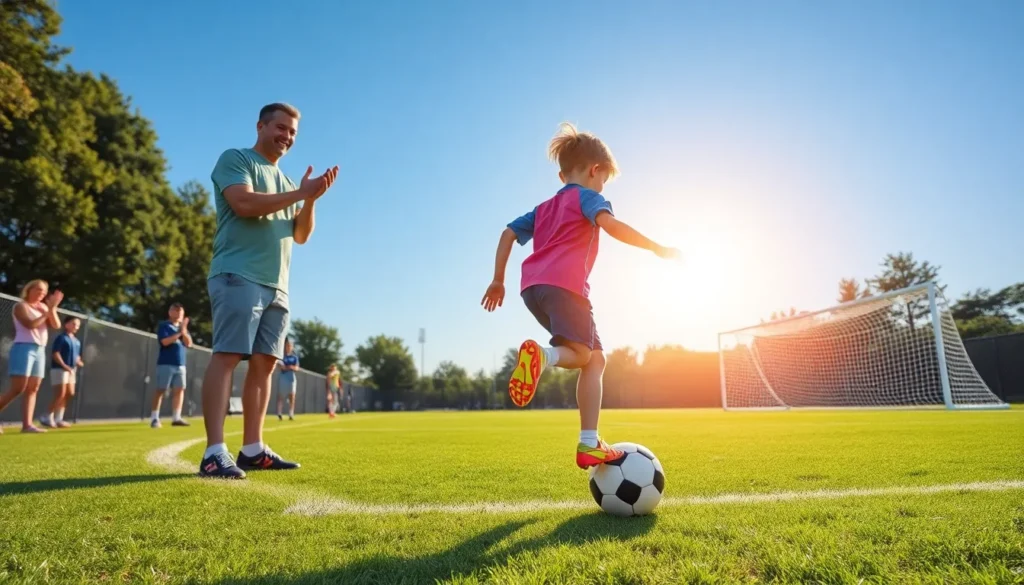When it comes to kids and sports, the right gear can make all the difference. It’s not just about looking cool on the field; it’s about safety, performance, and a dash of fun. Imagine your child zipping past the competition in shiny new sneakers while you sit back, sipping your coffee, and feeling like the ultimate sports parent.
Overview of Kids Sports Gear
Kids sports gear plays a crucial role in ensuring safety and enhancing performance. Selection includes items tailored for specific sports, such as soccer cleats, basketball shoes, and protective pads. Each piece of equipment serves a purpose, contributing to the overall experience of the sport. Footwear remains one of the most critical components of kids sports gear. Proper shoes provide support, traction, and comfort, reducing the risk of injuries. For instance, soccer cleats feature specialized studs that aid in grip and stability on the field. Protective gear is equally important. Helmets, knee pads, and shin guards protect young athletes from potential injuries. Many parents prioritize finding gear that fits well while complying with safety standards established by organizations like the American Society for Testing and Materials (ASTM). In addition to safety, quality sports gear can enhance performance. Wearing lightweight apparel allows for greater flexibility and improved movement. Fabrics designed to wick moisture away from the body help keep kids comfortable during vigorous activities. Consider the durability of materials used in manufacturing sports gear. High-quality equipment withstands daily wear and tear, ultimately saving money on replacements. Brands like Nike, Adidas, and Under Armour are known for producing long-lasting items fit for active children. Fit and comfort are vital factors when selecting kids sports gear. Gear that doesn’t fit properly can hinder performance and lead to frustrations on the field or court. Therefore, parents should involve their children in the selection process to ensure the right fit and preferred styles. Investing in appropriate sports gear encourages active lifestyles and builds confidence in young athletes. Many parents see their children excel in sports when equipped with the right gear, significantly enhancing their overall enjoyment and commitment.Importance of Choosing the Right Gear

Safety Considerations
Safety remains a top priority when selecting kids sports gear. Wearing well-fitted helmets can significantly reduce the risk of head injuries. Protective pads, such as knee and elbow guards, shield children during contact sports, promoting safer play. Equipment meeting safety standards offers peace of mind. Choosing shoes with proper grip and ankle support helps minimize slips and falls, further safeguarding young athletes. It’s crucial for parents to evaluate the durability of gear, ensuring it withstands the rigors of active play. Inspections for wear and tear keep gear reliable and effective, guaranteeing safety during every game.Performance Enhancement
Performance enhancement is another important factor in selecting sports gear for kids. Lightweight materials contribute to improved agility, enabling children to move more freely. Moisture-wicking fabrics help regulate body temperature, keeping young athletes comfortable during intense activities. Shoes designed for specific sports provide tailored support and traction, enhancing overall performance on the field or court. Engaging children in the selection process promotes awareness of what gear helps them play their best. Optimal gear can foster confidence, encouraging kids to push their limits and fully enjoy their sporting experiences.Types of Kids Sports Gear
Kids’ sports gear encompasses various items that cater to their needs in different sports. Understanding these types facilitates better choices for parents and young athletes.Apparel
Apparel includes specialized clothing designed for performance and comfort. Moisture-wicking fabrics keep children dry, enhancing their ability to focus. Lightweight options promote ease of movement, which aids agility. Each sport typically requires specific clothing, like jerseys for soccer or shorts for basketball. Finding well-fitting apparel ensures optimal performance while encouraging a sense of pride in one’s appearance.Footwear
Footwear plays a pivotal role in a child’s sports experience. Quality sports shoes provide support and traction, which minimizes injury risks on the field or court. Sports like soccer necessitate cleats for grip, while basketball requires high-tops for ankle support. Selection must focus on fit and comfort, as improper footwear can hinder movement and performance. Parents should consider brands known for their durability and child-friendly designs.Protective Equipment
Protective equipment safeguards children during physical activities. Helmets are crucial in contact sports like football, effectively reducing the risk of head injuries. Knee pads and elbow guards offer added security, especially in sports involving falls or collisions. Each piece of protective gear must fit correctly to ensure maximum efficacy. Prioritizing quality gear enhances safety and promotes confidence in young athletes while they play.Accessories
Accessories complete a child’s sports gear collection. Items like water bottles keep young athletes hydrated during practices and games. Sports bags provide convenient storage for gear, ensuring easy transportation. Mouthguards protect teeth during contact sports, making them essential for safety. Engaging children in selecting accessories fosters a sense of ownership and responsibility.Tips for Selecting Kids Sports Gear
Selecting the right sports gear for kids involves careful consideration across various dimensions. Understanding specific elements ensures they receive the best fit and support for their activities.Age and Size Considerations
Age influences both size and type of gear needed. Measure a child’s height and weight to determine the appropriate size. Clothing sizes often vary across brands, so checking each brand’s size chart remains crucial. Young athletes experience rapid growth; buying a little extra room ensures longevity. Children who participate in competitive sports may require gear reflecting specific age categories to enhance safety and performance.Activity-Specific Needs
Different sports demand unique gear. Soccer requires cleats with good traction for running on grass, while basketball calls for high-top shoes to support ankles. Protective gear, including helmets for cycling or pads for contact sports like football, ensures safety during play. Familiarity with the specific requirements of each sport helps in making informed choices. It’s important to prioritize comfort alongside functionality to encourage enjoyment and performance.Budget-Friendly Options
Affordability plays a significant role in selecting sports gear. Parents might consider purchasing second-hand items from trusted sources to save money. Quality brands offer sales and discount options, making it easier to find affordable yet reliable gear. Setting a budget can prevent overspending while still ensuring children receive the necessary items. Comparing prices among retailers can reveal better deals and maximize value, allowing investments in quality gear without breaking the bank.Conclusion
Choosing the right sports gear for kids is essential for their safety and performance. Parents play a crucial role in ensuring their children have well-fitting equipment that meets safety standards. By involving kids in the selection process, they foster a sense of responsibility and ownership over their gear. Investing in quality sports gear not only enhances enjoyment but also helps build confidence in young athletes. With the right equipment, children can focus on improving their skills and embracing an active lifestyle. Prioritizing fit, comfort, and safety will lead to a more rewarding sports experience for both kids and parents alike.
Investing in quality sports gear not only enhances enjoyment but also helps build confidence in young athletes. With the right equipment, children can focus on improving their skills and embracing an active lifestyle. Prioritizing fit, comfort, and safety will lead to a more rewarding sports experience for both kids and parents alike.

